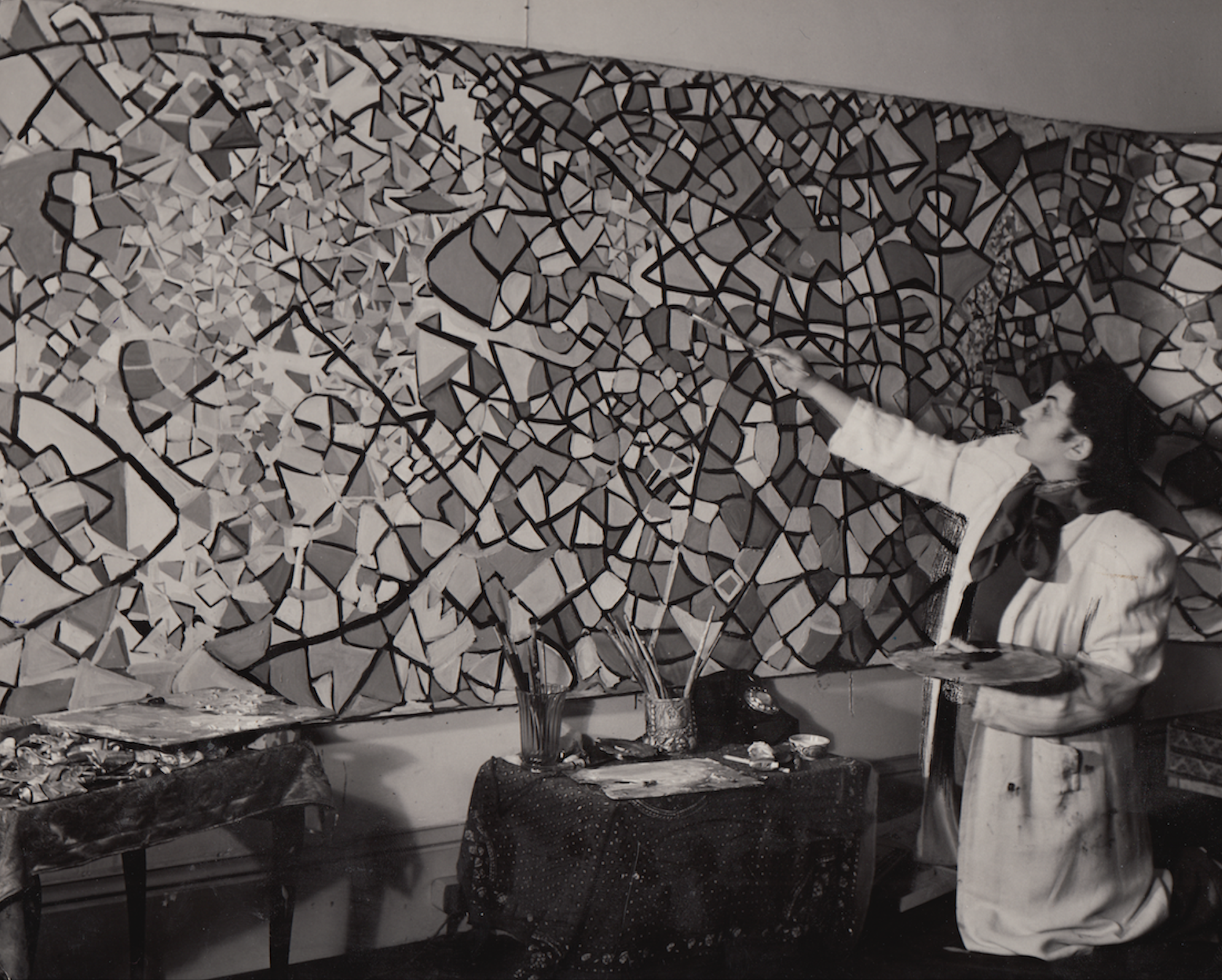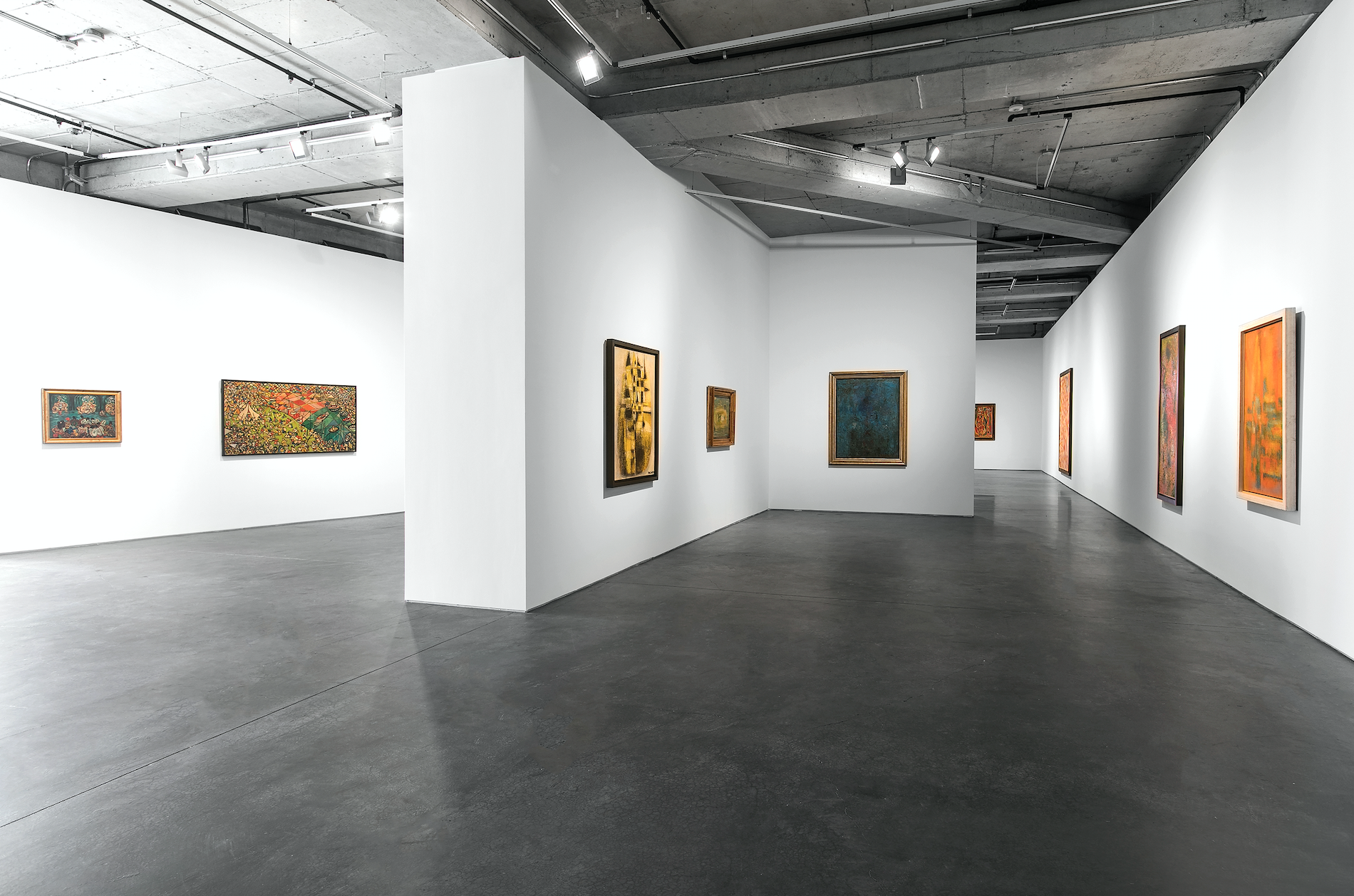In the London studio painting Voyage of the Man Moon, 1949 (Fahrelnissa Zeid, Painter of Inner Worlds, Lalidi-Hanieh, Adila, p. 103)
Understanding the creative process of Fahrelnissa Zeid
Hatice Utkan Özden
8-9 min. read / scroll down for text in Turkish
What makes Fahrelnissa Zeid so special as a painter is the fact that her creative process is clearly reflected on her works as a representation of her inner world. It is possible for the viewer to trace Zeid's grievance, sorrow and sadness on her paintings in guises of light, color and brushstrokes. Her self-awareness, while reflecting her individualism and thought processes into her work, has made the world acknowledge Zeid as the expressionist painter of abstract and figurative baroque paintings (Fahrelnissa Zeid: Painter of Inner Worlds, Adila Laidi-Hanieh, page 7). However, Zeid was never just a painter. Painting was just a mean of production in her journey to rediscover herself and celebrate her creativity. For that very reason, Zeid was able to display her whole existence full-heartedly as she argued that she needed to paint since 'One cannot be self-sufficient' (Fahrelnissa Zeid: Painter of Inner Worlds, Adila Laidi-Hanieh, page 9).
The book titled, Fahrelnissa Zeid: The Painter of Inner Worlds, written by Adila Laidi-Haniah and published by RES Publications with the support of Dirimart is a treasure for those who would like to understand Zeid’s art and her personality. Book gives essential insight on how Zeid’s thoughts and feelings have changed during her creative process and details regarding her scope of work. The book may just provide information on Zeid's personal life for the reader who already know her but for those who meet Zeid for the first time, it gives a more dimensional discovery regarding her artistic approach. The exhibition at Dirimart accompanying the book provides a spectacular look at Fahrelnissa Zeid's life and art. As her son Emir Zeid Prince bin Raad says: ''Each painting tells a story on a sequence of her life.'' and these stories show us the pain and joy of her creative process. As each step in her life proves, Zeid is an artist who is destined to make her self-actualization possible through those steps taken to reach her destiny.
That is why it is essential to approach Fahrelnissa’s works with a question in our heads: ''What can I learn from her?’' and this question leads us to so many new findings about ourselves and her creativity.
Fahrelnissa Zeid, ‘Ode to Passion’, Dirimart 2018. Installation Shots by Nazlı Erdemirel.
Unbearable heaviness of melancholy
Zeid’s paintings may bewitch the viewer with its immense colors and light. However, what is hidden in them is the in-depth spiritual process. Melancholy of Zeid brings her to the verge of depression which also leads to a creative process together with a suicidal tendency. During these sad times, she only paints and the activity of creating becomes her only hope. However, she never finds comfort. Sometimes she makes the same drawing over and over. This is a period when she discovers her soul’s depths and understands herself better. However, the doubts and uneasiness in her mind never let her express herself easily and without hesitation. Melancholy feeds her passion for painting but leaves a heavy burden on her. She can bear this heaviness, and she gets stronger in each crisis, and she starts to paint for more extended hours. Her son says when she paints she is in a complete trance and she excludes herself from the outer world. Finally, in 1945 she gains recognition in Turkey with her solo exhibition which becomes a gift to her after the hard times.
Combining various concepts in different medium: Writing and drawing
As a painter, Zeid always searches for different approaches to her expression, maybe instinctively even if not on purpose. She loves to discuss and explain the creative process and she uses writing to do that.
Laidi-Hanieh says: ‘‘Zeid, both draws and writes. Her paintings do not appear by accident. She plans before painting. She draws and then she writes about them. She spends long hours on her first draft drawings before creating the paintings.’
The best example for this, is the production of her painting My Helland her writings during the process. Zeid created this painting when she was in pain, after the death of Queen Aliya. She wrote: ‘began to feel miserable […] after so many preparations of the mind, and expenses it cost […] lost in the incommensurable depth of my mind’ (Fahrelnissa Zeid, The Painter of Inner Worlds, Adila Laidi-Haniah, pages 131-132). While in this misery, Fahrelnissa sees a fly on the canvas and she starts following it with a pen. At the point where she stops, she starts laughing as the whole canvas has lines on it. She finds something to express her pain with, and she has written about it very directly in her writings. Laidi-Hanieh says, she wrote about all her methods and this is a significant part of her creative process.
She almost becomes professional on keeping a journal and expressing her thoughts and feelings by writing. In many books, she criticizes herself, her paintings and maybe in doing so, she speaks with her paintings.
Fahrelnissa Zeid, ‘Ode to Passion’, Dirimart 2018. Installation Shots by Nazlı Erdemirel.
Owning her anguish
Fahselnissa Zeid could own her anguish and she used the pain on her way to becoming an artist and creating different styles in her painting. When she had her first depression, she said she was desperate and admitted that the pain was so big it left her almost paralyzed. She lived with that pain without hesitating and maybe through that courage, she reflected all her emotions onto her paintings. It is fair to say she never loved pain, but she admitted its existence and lived with this awareness. She reached a certain maturity to accept her pain. Her paintings and her eagerness for creativity supported her.
Laidi- Hanieh, wrote about her times in Iraq, when she was in depression and established an atelier in her room. However, her efforts to avoid depression did not work, and her husband brought in a psychiatrist for her. Meanwhile, Fahrelnissa accepts the pain and she tells her husband that she no longer wants to paint. However, the doctor insists that she needs to paint and she agrees.
Fahrelnissa Zeid, ‘Ode to Passion’, Dirimart 2018. Installation Shots by Nazlı Erdemirel.
Residing only in art
According to Zeid, an artist should have a pure language without the interference of language, religion, and race. She says her paintings reach far too deep and then goes to the surface. Even though she comes from an influential family and she is an actual princess, her home is her art. She explains that state of mind in her own words: ‘When I paint, I feel as if a tree of life is rising from the very roots […]to one of its topmost branches, where I happen or try to be, and then surging through me to transform itself into forms and colors on my canvas.’
This intense state of belonging mostly showed itself during the time she spent in Nouvelle Ecole de Paris. Even though her style and personality were different than the others, she manages to have a place in the Paris art scene. She receives positive reviews in Paris. During this period, her style develops and she proves that her only concern is to become a significant artist.
Regenerating and progressing
In 1959, after the coup in Iraq, Fahrelnissa witnessed many deaths in her family which led her to another period of depression in her life. She overcomes this misery by renewing herself and her art. After that period, her whole life changes which also leads to a change in her way of creating. Her paintings become more and more spiritual and her creativity evolves into another dimension. She names her paintings such as Resurrection, Fatality and Ghost Ship. Those paintings also reflect the new chapter of her life.
After that period, Zeid and her husband move to London and start leading a more modest life. On a New Year’s Eve, she goes to her kitchen – even though she is not a great cook, cooks a perfect turkey and does not want to throw away the leftovers. She suddenly decides to paint the bones and just like that, she develops a different artistic technique which she will use for the rest of her life. This technique would take her production to a period of paleo-crystal works and modern acrylic paintings. Ultimately, Zeid decides that she needs to channel her profession into teaching. Perhaps, this is the main reason how Haniah-Laidi has written the book as her mother was Fahrelnissa’s student. Laidi’s mother who was a novelist wanted to write the life story of Zeid. However, her publisher was not interested in publishing the sotry at the time. After many year, Adila takes the torch and tells about the legacy of Fahrelnissa Zeid.
Fahrelnissa Zeid, ‘Ode to Passion’, Dirimart 2018. Installation Shots by Nazlı Erdemirel.
Fahrelnissa Zeid’in yaratıcılık süreçlerini anlamak üzerine
Hatice Utkan Özden
8-9 dakika okuma süresinde
Fahrelnissa Zeid belki de bir ressam olarak düşünce, yazı ve iç dünya temsillerini en iyi yansıtan sanatçılardan biridir. Onun dünyası ve düşünceleri, kesin sonuçlar olarak resmine yansımıştır. Bunun sonucunda da bizlerin onun eserlerinde renk, ışık ve hareket olarak gördüğümüz her detay, aslında onun sıkıntıları, hüznü ve üzüntüsüdür. Zeid resme, tüm acılarını ve sıkıntılarını bireyselliğinin ve düşüncelerinin var oluş süreçlerinin farkında vararak yansıtmıştır. Şimdi, dünya sanatı onu renklerin, soyut ve figüratif barok dışavurumcu eserlerin (Fahrelnissa Zeid, İç Dünyaların Ressamı, Adila Laidi-Haniah, sf. 7) ressamı olarak görmektedir. Ancak, Zeid’in yaşadığı zamanın ve dünyanın bir gerçeği varsa, o da, Zeid’in bu gerçeği tüm farkındalığıyla yaşayan ve yansıtabilen bir sanatçı olmasıdır. Zeid aslında sadece resim yapmaz. Aslında, o üretmek ve yaratmak için yaratmaz, onun amacı yaratıcılığı ön plana koyarak bir şeyler yapmaktır ve aracı da resimdir. Onun için resim yapmak kendini tekrar ve tekrar keşfetmek ve yaratıcılığını kutlamak için bulduğu bir yoldu. Zeid, bu yüzden resimlerde kendi dünyasını tüm açıklığı, ve cesaretiyle yansıtabilir. Onun resme her zaman ihtiyacı vardır, bunu da ‘Kişi kendine yetmez’ diyerek savunmuştur. (Fahrelnissa Zeid, İç Dünyaların Ressamı, Adila Laidi-Haniah, sf. 9)
Dirimart’ın desteğiyle Türkçe çevirisinin RES yayınlarından yayımlandığı Adila Laidi-Haniah’ın, Fahrelnissa Zeid, İç Dünyaların Ressamı adlı kitap, Zeid’in hem kişiliğini, hem de sanatını harmanlayarak yazılan bir sanat kitabı niteliğinde. Kitap, Zeid'i tanıyan okuyucu için, onun özel yaşantısı ve ilişkilerine dair aydınlatıcı noktalar içermekte. Onu yeni tanıyanlar için ise, sanatının detaylarına ve içsel derinliğine bir giriş niteliğinde. Bu kitabın lansmanına eşlik eden Dirimart'taki Fahrelnissa Zeid sergisi ise sanatçının hayatına dair bir görsel şölen sunar. Oğlu, Prens bin Raad’ın da söylediği gibi, her resim yaşantısından bir hikaye ve kesit anlatır.
Bu hikaye bize yaratıcılık süreçlerinin kaçınılmaz sancısını, bazen de coşkusunu gösterir. Ama ne olursa olsun, Zeid’in her adımı kendini gerçekleştirmek ve kaderine ulaşmak için yapılan bir hamledir.
Bu nedenle aslında onun eserlerine ve hayatına bakarken, kendini gerçekleştirmek adına; Fahrelnissa Zeid’den neler öğrenebiliriz sorusuyla yaklaşmak hem kendimize, hem de iç dünyasını bizlerle paylaşmak isteyen sanatçıya dair birçok şey öğrenmemizi sağlayabilir. Onun yaratıcılık süreçleri bizlere yaşantımızla ilgili birçok farkındalık kazandırabilir.
Fahrelnissa Zeid, ‘Ode to Passion’, Dirimart 2018. Installation Shots by Nazlı Erdemirel.
Melankolinin dayanılmaz ağırlığı
Zeid’in resimleri renk cümbüşü olarak ilk andan izleyiciyi büyüleyebilir ama içinde bize hatırlatmak istediği şey, resmin derin ruhani durumunu yansıtmaya çalışır. Sanatçının içine girdiği melankolik dönemler ve bu dönemlerin beraberinde getirdiği depresyon krizleri onu, intihar eğilimiyle birlikte gelen uzun bir yaratıcılık sürecinin içine iter. Bu süreçlerde sürekli resim yapar ve yeni bir şeyler yapmak ona iyi gelir. Ancak, neredeyse hiç rahat edemez. O dönemlerde bazen sürekli aynı resimleri yapar, diğer yandan, hızlı ve verimli bir yaratıcılık sürecidir onunkisi... Belki de kendine dair en derinlere indiği ve kendini en iyi şekilde ifade ettiği ama aklındaki şüpheler yüzünden bunu asla sesli ifade edemediği çekingen bir süreçtir. Diğer yandan, melankoli onun resim tutkusunu besler ama onun üzerinde ağırlık bırakır. Bu ağırlığı kaldırabilir sanatçı, sanki her krizde daha dayanıklı olmuştur ve bu uzun süreler resim yapmaya başlar. Oğlu, Prens bin Raad’ın da söylediği gibi, o resim yaparken tamamen transa geçer ve dış dünyayla ilişkisini keser. Bu süreçte sürekli yaratıcılık içinde yaşar ve ardından 1945 yılında Türkiye’de açtığı sergiyle bir anda Türk sanat ortamında parlar. Böylece, bu derin krizli dönem, sonunda ona bir hediye olarak geri döner.
Farklı kavramları ve farklı mecraları birleştirebilmek: Hem yazabilmek, hem çizebilmek
Bir ressam olarak Zeid her zaman farklı ifade biçimleri peşinde koşar. Bunu belki de bilerek yapmaz, bu onun yaşantısında kendiliğinden gelişen bir olgudur. O, yaratıcılık süreçlerini açıklamayı sever ve bunu yaparken de yazının ve dilin inceliklerini kullanır. Laidi-Hanieh bunu şu şekilde açıklıyor: ‘‘Zeid, hem yazar, hem de çizer. Onun resimleri bir tesadüf üzerine ortaya çıkmaz. Her anını planlar. Eskiler çizer ve bunlar üzerine yazılar yazar. Uzun düşünce süreçlerinin yazıya aktarılmış ve sonunda da resim haline gelmiştir Zeid’in eserleri.’’
Belki de bunu en iyi anlatan örnek ise, Zeid’in Cehennemim adlı tablosuyla ilgili yazdıklarıdır. Zeid bu tabloyu büyük bir acının eşiğindeyken yaratmıştır. Tabloyu, Kraliçe Aliye’nin ölümünün ardından yapmıştır. Bu tabloyla ilgili yaratıcılık sürecine dair şunları söylemiştir: ‘‘Zihnimin kıyaslanamaz derinliklerinde kaybolmuş, kendimi sefil hissetmeye başlamıştım.’’ (Fahrelnissa Zeid, İç Dünyaların Ressamı, Adila Laidi-Haniah, sf. 127). Bu çaresizlik içindeyken Fahrelnissa tablonun üzerinde bir sineğin dolaştığını görür. Sineğin gölgesinin tuvale yansıdığını fark eder ve eline bir kalem alır sineği tuval üzerinde takip etmeye başlar. Bunu bir müddet yapar ve sonra durur. Tüm tuval kurşun kalemle çizilmiştir ve kendi kendine gülmeye başlar. Bu karışıklık içinde kendi acısını çözebilen bir şey bulmuştur ve bunu da yazıyla ifade ederken oldukça net ve direktir.
Fahrelnissa, kendi içini de sayfalara dökmekte ustalaşmıştır. Birçok kez kendini ve çalışmalarını eleştiren ve sorgulayan bir tavır takınır ve bu yazılar sayesinde resimleriyle, kendisiyle konuşur.
Fahrelnissa Zeid, ‘Ode to Passion’, Dirimart 2018. Installation Shots by Nazlı Erdemirel.
Acıyı sahiplenmek
O, bir sanatçı olarak acısını sahiplenebilen ve bunu da belirli aralıklarla yaşantısında ve resminde ‘farklılaşma’ olarak kullanabilen bir yapıya sahipti. Örneğin, ilk depresyon krizini anlatırken ‘Hüzün ve somurtkanlık dalgaları’ içinde olduğunu söylemiş ve bunun onu neredeyse hareketsiz bırakacak kadar acı verici olduğunu da söylemişti. Tüm bunları bizler okurken (dile kolay) sadece hastalık olarak algılayabiliriz ama onun acısı gerçekti. Ruhunun azap içinde olduğunu söylemekten çekinmeden kendini sadece resme verdiğini yazmıştı. Acıyı sevmeden ama onun varlığını kabullenerek, belki de kendinin aslında duygularından ibaret olmadığını görerek yaşamıştı. Bunu yapabilmek için gerekli olgunluğu ise resimden ve sanattan alıyordu. Laidi- Hanieh, Irak’taki ilk zamanlarla ilgili şöyle yazıyor: ‘‘Depresyonun eşiğindeyken evine kurduğu atölye yerine burada (odasında) çalışmayı tercih eder.’’ Ancak, tüm bunlar pek de işe yaramaz ve Emir Zeid, eşi için bir psikiyatrist getirtir. Fahrelnissa ise acısını kabullenmiştir ve artık resim yapmak istemediğini söyler. Ancak, psikiyatristin de önerisiyle resim yapmaya devam eder.
Sadece sanata ait olmak
Ona göre gerçek bir ressam dil, din, ırk olmaksızın saf bir dile sahip olmalıdır. Bunu ifade etmek için de resimlerinin, cinsiyet, ırk ve dinin dışında kalarak, çok daha derinlere uzanan uzanarak yüzeye çıktığını ifade eder. Ona göre ait olunması gereken tek şey sanattır. O, her ne kadar ünlü bir aileden gelse de ve bir prenses olsa da, aslında resim yaparken bir ‘hayat ağacının köklerinden en yüksek dallarına kadar yükseldiğini hisseder’ (Fahrelnissa Zeid, İç Dünyaların Ressamı, Adila Laidi-Haniah, sf. 185).
Bu aidiyetlik meselesini en çok da Nouvelle Ecole de Paris yıllarında yaşar. Aslında, bu üslubun dışında kalmasına rağmen, kendine bu ortamda bir yer edinmeyi başarır. Hatta Paris ortamında farklı galerilerde sergiler açar ve övgü dolu sergi kritikleri yazılır. Bu dönemde üslubu da gelişir ve tek derdinin sadece sanatçı olarak görülmek olduğunu kanıtlar.
Fahrelnissa Zeid, ‘Ode to Passion’, Dirimart 2018. Installation Shots by Nazlı Erdemirel.
Yenilenebilmek ve Yenilikçi olabilmek
1959 yılında Irak’ta soylulara yapılan darbe sonrasında, birçok kişinin ölümüne tanıklık eden Fahrelnissa Zeid, bu dönemin ardından büyük bir buhran yaşar. Bu trajediyi ise sadece sanatında ve kendi içinde bir yenilenme ile yener. Bu dönemin ardından tüm hayatı değişir ve bununla birlikte yaratıcılık süreci ve üretimleri de farklılaşır. Resimleri daha ruhani bir boyuta doğru ilerlerken yarattıkları da farklılaşır. Resimlerine Hortlaklar, Ölümcüllük ve Hayalet gemi gibi ruhsal isimler vermektedir. Bu dönemde resimler aslında onun yeni yaşantısına da göndermeler yapıyordu.
Bu sürecin ardından, bir prenses olarak devam ettiği yaşantısından uzaklaşır ve daha mütevazi bir yaşam sürmeye başlar. Bir yılbaşı günü yemek pişirmek için mutfağa girer, aslında yemek yapmayı çok bilmez ama yılbaşına yakışır şekilde bir hindi yapar ve yemek sonrasında geriye kalan kemikleri atmak istemez. Bu kemikleri saklar ve onları boyar. Böylece, yaşantısında sanata sıfırdan başlayarak yeni bir yol çizer. Bu üslup onu, paleo-kristal denen üretimlerinden yeni tarz yağlı boyalara kadar yeni bir döneme yönlendirir. Sonunda ise Fahrelnissa Zeid, tüm bildiklerini aktarmayı seçer. Belki de bir şeyler öğretmek ve öğrenci kazanmak onun yaşantısı içinde onu en çok besleyen şey olmuştur. Adila Laidi-Haniah ise işte bu dönemin bir parçasıdır. Haniah’ın annesi Zeid’in öğrencilerinden birisidir. Aslında Zeid’in yaşamının öyküsünü, Adila’nın annesi yazacaktır, çünkü, bir romancıdır ama o dönemde yayıncısı bu konuyla ilgilenmez ve Adila’da annesinden ve Zeid’den ona kalan bu mirası okuyucuyla buluşturur.









